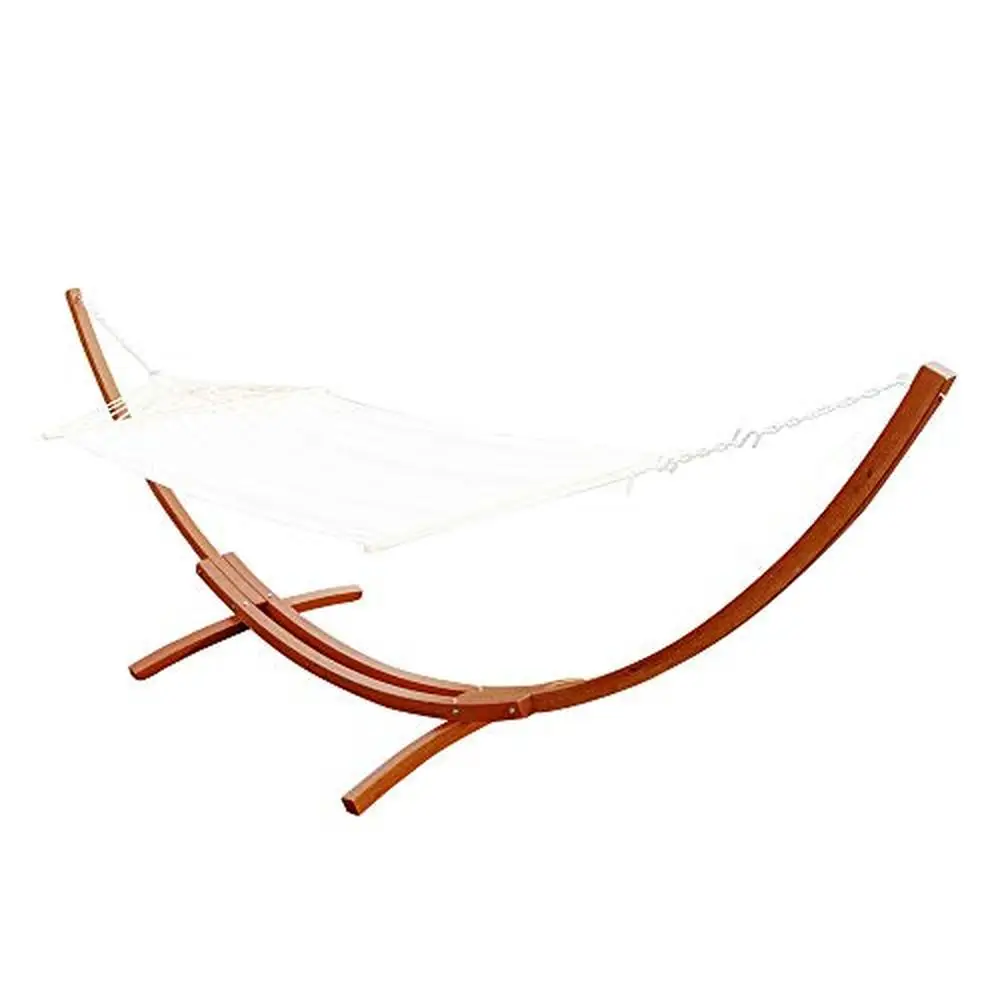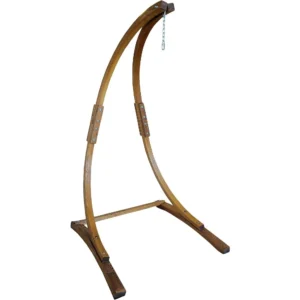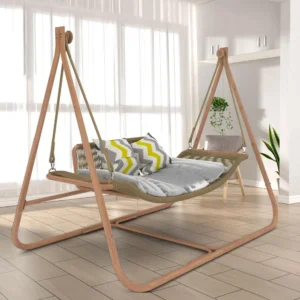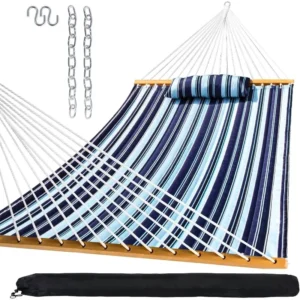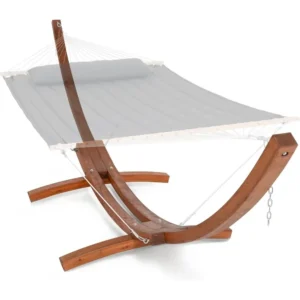Understanding the Importance of Quality Materials in Spreader Bar Hammock Systems
Spreader bar hammocks stand apart from traditional hammocks through their distinctive design feature – the wooden or metal bars at each end that stretch the hammock fabric taut. This creates a flat, stable surface for lounging rather than the cocoon-like wrap of conventional hammocks. The materials used in these systems aren’t merely a design choice – they’re fundamental to the entire hammock experience.
The quality of materials in a spreader bar hammock system directly impacts three critical factors: safety, comfort, and longevity. Premium materials typically support greater weight capacities (often 450+ pounds compared to standard options at 250 pounds), resist weather damage, and maintain their aesthetic appeal over time. The wrong materials can lead to premature aging, structural failures, or uncomfortable relaxation experiences.
Both primary components – the spreader bars themselves and the supporting frame or stand – require careful material selection for optimal performance. Environmental factors such as humidity, sunlight exposure, and temperature fluctuations affect different materials in vastly different ways. Proper indoor and outdoor hammock placement decisions must account for these material properties to ensure long-term satisfaction.
For those investing in premium hammock systems, understanding the material differences becomes even more crucial as quality directly correlates with the enjoyment and value received over many years of use.
Wood Materials for Spreader Bars: Natural Elegance Meets Function
Wood remains the classic and most popular choice for spreader bars, blending natural beauty with practical functionality. The ideal wood for spreader bars must strike a delicate balance: sufficient strength to support weight without bending, light enough to remain comfortable, and resistant to moisture and UV damage.
Premium wooden spreader bars require specific characteristics that not all woods can provide. The strength-to-weight ratio is particularly important – the wood must be sturdy enough to maintain tension without adding unnecessary bulk. Additionally, quality wooden spreader bars undergo specialized treatments that enhance their natural properties and extend their lifespan.
Several hardwoods stand out as exceptional choices for high-quality spreader bar hammock sets:
Southern White Oak
* Renowned for exceptional structural strength and natural resistance to warping
* Typically treated with marine-grade varnish for additional weather protection
* Natural tannins provide resistance against fungal growth and insects
* Premium options feature multiple coats of UV-resistant finish
Bamboo
* Technically a grass but functions like a hardwood with impressive strength
* Naturally contains silica, providing resistance to water damage
* Environmentally sustainable due to rapid growth cycles
* Lightweight yet capable of supporting substantial weight
Laminated Hardwoods
* Created by bonding multiple wood layers with waterproof adhesives
* Enhanced stability and resistance to warping compared to solid woods
* Allows for curved designs that might be impossible with solid wood
* Often features decorative outer veneers for aesthetic appeal
The best wooden hammocks and stands incorporate these premium materials with proper treatment for maximum durability while maintaining a warm, inviting appearance that synthetic materials simply cannot match.
Metal Alternatives for Spreader Bars: Modern Durability Solutions
While wood dominates the spreader bar market, metal options present compelling alternatives for specific needs and preferences. Aluminum spreader bars, in particular, offer distinct advantages that make them increasingly popular in contemporary hammock designs.
Aluminum spreader bars excel in several key areas:
* Substantially lighter than comparable wooden bars, reducing stress on hanging points
* Inherently resistant to rust and corrosion without additional treatments
* Clean, sleek aesthetic that complements modern outdoor spaces
* Consistent performance in humid environments where wood may swell
Premium aluminum spreader bars utilize aircraft-grade alloys rather than basic aluminum, providing superior strength and rigidity. These bars often feature specialized anodizing treatments that harden the surface while adding color options beyond natural metal tones.
When comparing metal to wooden spreader bars, comfort considerations come into play. Metal bars generally transfer more movement through the hammock system, potentially reducing the stability feeling that many users prefer. However, advanced engineering in premium options minimizes this effect through subtle design modifications and vibration-dampening elements.
Maintenance requirements strongly favor metal options. While wooden bars might need annual resealing or refinishing, quality metal spreader bars typically require nothing more than occasional cleaning to maintain their appearance and performance.
Premium Wood Options for Hammock Frames: Combining Beauty and Strength
The hammock frame or stand serves as both the structural foundation and a significant design element of your relaxation space. Premium wooden frames elevate the entire hammock experience through their natural beauty and substantial feel.
Select hardwoods offer specific properties that make them ideal for hammock frame construction:
Teak
* Contains natural oils that repel water and prevent rot without additional treatments
* Develops a distinguished silver-gray patina if left untreated
* Exceptional dimensional stability prevents warping even in challenging environments
* Investment-grade durability with lifespans measured in decades rather than years
Cypress
* Natural compounds resist water penetration and insect damage
* Performs exceptionally well in humid environments without swelling
* Straight grain provides consistent strength throughout the structure
* Pleasant, subtle aroma adds to the sensory experience
Cedar
* Aromatic oils naturally repel insects and resist decay
* Lightweight relative to its strength, making assembly and positioning easier
* Distinctive reddish tones complement various outdoor settings
* Minimal tendency to split or crack when properly finished
The construction methods used in premium wooden frames are just as important as the wood itself. Quality wooden arc stand hammock sets feature robust joinery techniques such as mortise and tenon connections or reinforced bolted joints rather than simple screws. These methods distribute weight more effectively and prevent loosening over time.
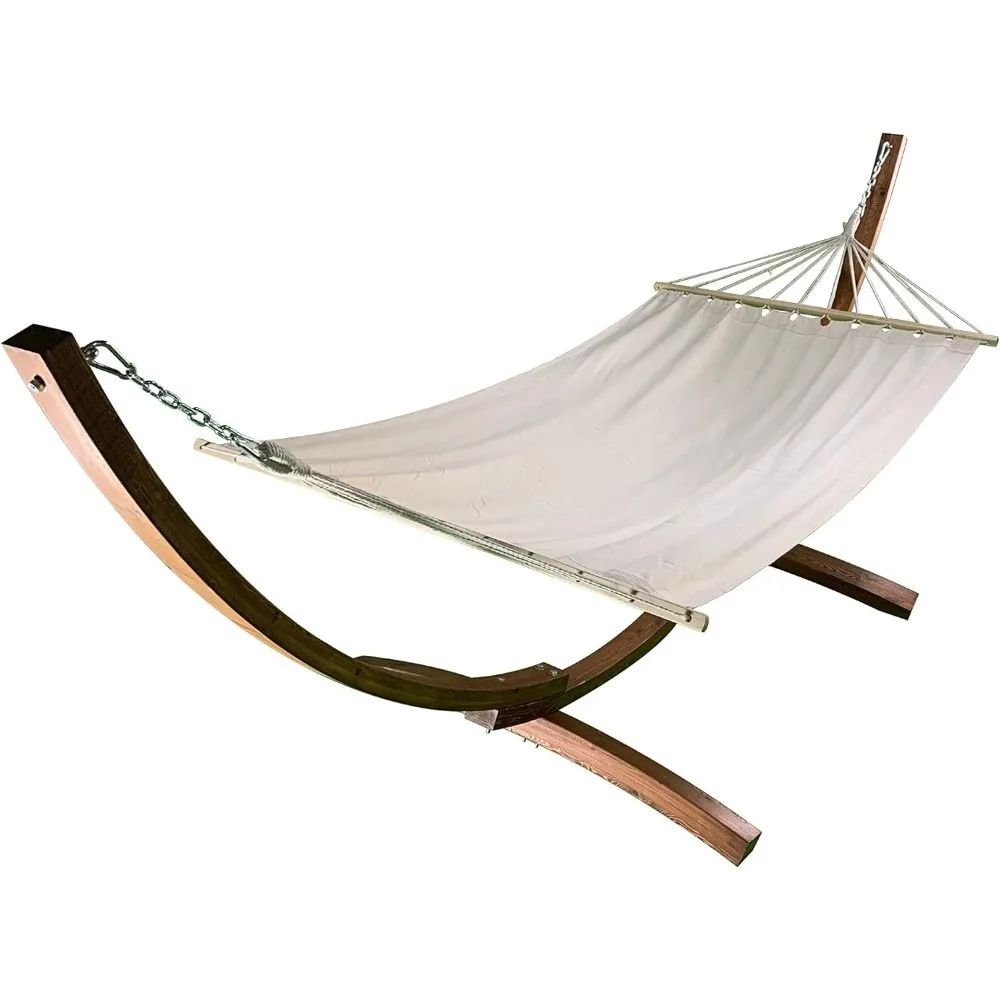
Proper maintenance of wooden frames involves periodic inspection for finish integrity and prompt attention to any exposed wood. Most premium options require refinishing every 1-3 years depending on environmental exposure, with teak requiring the least intervention and pine needing the most.
Metal Frame Construction: Engineering for Stability and Longevity
Metal hammock stands represent the pinnacle of modern engineering applied to relaxation furniture. Their structured design principles focus on creating maximum stability with optimal material use, resulting in frames that combine strength with clean visual lines.
The steel used in quality hammock stands varies significantly from budget options:
Powder-Coated Steel
* Heavy-gauge tubing (typically 1.5-2” diameter with 1/8” wall thickness)
* Multi-stage powder coating process creates a tough, damage-resistant finish
* Available in various colors while maintaining uniform durability
* Resistant to chipping, scratching, and UV fading
Stainless Steel
* Premium 304-grade stainless offers exceptional corrosion resistance
* Ideal for coastal environments with salt exposure
* Maintains its appearance without additional protective coatings
* Higher initial cost offset by minimal maintenance requirements
Aluminum Options
* Ideal when portability is a priority due to significantly lighter weight
* Special alloys provide necessary strength despite weight reduction
* Naturally resistant to rust and corrosion without additional treatments
* Often features reinforced connection points to compensate for material flexibility
Premium metal stands differentiate themselves through superior welding techniques, reinforced stress points, and high-grade hardware. Budget stands often utilize thin-wall tubing with spot welds and basic hardware that deteriorates quickly outdoors. Understanding the strongest materials for hammock stands helps in distinguishing quality differences that affect both safety and longevity.
One common misconception is that all metal stands are equal in strength. In reality, design engineering matters as much as raw material – properly distributed support points and triangulated structures create significantly more stable experiences than simplistic designs using the same metals.
Dark Wood Hammock Sets, Porch Swing Chair Sets
$653.82 Select options This product has multiple variants. The options may be chosen on the product pageLight Wood Hammock Sets, Swinging Hammock Chair Sets
$1,359.35 Select options This product has multiple variants. The options may be chosen on the product pageClassic Wooden Stand Hammock Sets, Heavy Duty Hammock Sets
$1,061.68 Select options This product has multiple variants. The options may be chosen on the product pageHammock Sets with Canopy, Heavy Duty Hammock Sets
$286.31 Select options This product has multiple variants. The options may be chosen on the product pageHeavy Duty Hammock Sets, Wooden Arc Stand Hammock Sets
$878.66 Select options This product has multiple variants. The options may be chosen on the product page
Material Selection Guide: Matching Your Environment and Needs
Choosing the ideal materials for your hammock system requires understanding how different options perform in specific environments. This guide helps match your situation to the most appropriate materials for maximum enjoyment and longevity.
Indoor and Covered Outdoor Spaces:
* All wood types perform well with minimal maintenance
* Decorative woods like cherry or maple become practical options
* Powder-coated steel provides excellent stability with basic care
* Aesthetic considerations can take priority over weather resistance
Full Weather Exposure – Humid Climates:
* Teak, cypress and cedar outperform other woods significantly
* Marine-grade hardware becomes essential for all frame types
* Aluminum or stainless steel stands minimize maintenance concerns
* Consider combining wooden spreader bars with metal stands for balanced durability
Coastal Environments:
* Stainless steel stands provide superior salt-air resistance
* Teak is the premier wooden option for salt exposure
* Regular freshwater rinsing extends lifespan of all materials
* Specialized marine finishes are worth the additional investment
Seasonal Storage Requirements:
* Aluminum stands offer easier transport and storage
* Folding steel designs with quick-disconnect hardware simplify the process
* Wooden components benefit from indoor storage regardless of type
* Consider whether it’s okay to leave hammocks outside in your specific climate
For users prioritizing minimal maintenance, combining aluminum spreader bars with stainless steel stands creates an exceptionally durable system requiring almost no upkeep. Conversely, those seeking the classic aesthetic might pair teak spreader bars with a cypress frame for natural beauty that ages gracefully with modest maintenance.
When extreme weight capacity is needed, heavy duty hammock sets featuring steel stands with reinforced connection points provide the necessary support while maintaining an appealing appearance.
Essential Care Guide for Maximum Longevity
Proper maintenance dramatically extends the lifespan of any hammock system, with requirements varying significantly between materials. Following these care guidelines ensures your investment provides enjoyment for many years.
Wooden Component Care:
* Clean with mild soap and soft brush quarterly
* Apply fresh sealer annually for exposed locations, bi-annually for covered areas
* Check for water beading on surfaces – when water absorbs rather than beads, it’s time to reseal
* Inspect for cracks developing at end grain or connection points
* Store indoors during extended non-use periods if possible
Metal Component Care:
* Rinse occasionally with fresh water, especially after rain or high humidity
* Inspect hardware tightness at least twice per season
* Touch up any paint chips or scratches promptly to prevent corrosion spread
* Apply automotive wax to powder-coated surfaces annually for additional protection
* Store in dry location during extended winter periods
Seasonal care timing makes a significant difference in effectiveness. Apply protectants during moderate temperature days (60-80°F) to ensure proper curing and penetration. Spring preparation and fall winterizing represent the most critical maintenance periods for preserving material integrity.
With proper care, premium wooden components typically last 7-15 years outdoors, while quality metal frames can exceed 15-20 years. This care investment represents minimal time commitment compared to the extended enjoyment provided.
Advanced Material Technologies in Modern Hammock Systems
The hammock industry continues to evolve with innovative materials that enhance traditional options. These advancements combine classic aesthetics with improved performance characteristics.
Composite materials represent one of the most promising developments, particularly in spreader bar design. These engineered materials combine wood fibers with marine-grade polymers to create components that maintain wooden appearance while offering:
* Complete water resistance without additional treatments
* Immunity to insect damage and fungal growth
* Consistent performance regardless of humidity levels
* Dimensional stability preventing warping or splitting
Advanced wood treatment technologies have similarly revolutionized traditional materials. Pressure-infused stabilizers penetrate deep into wood fibers, creating protection that extends throughout the material rather than just surface coatings. These processes can double or triple the effective lifespan of wooden components without changing their appearance or feel.
Metal fabrication has seen equally impressive innovations. New aluminum alloys provide strength rivaling steel at significantly reduced weight, while advanced powder coating processes create finishes with self-healing properties that maintain appearance despite minor surface damage.
For environmentally conscious consumers, sustainably harvested woods and recycled metals have become increasingly available in premium hammock systems without compromising quality or aesthetics.
Material Compatibility with Hammock Fabrics and Accessories
Creating a cohesive hammock system requires understanding how frame materials interact with the fabric and accessories. This compatibility affects both aesthetics and functional performance over time.
Different spreader bar materials interact uniquely with various fabric types. Wooden bars tend to create less friction with cotton and polyester fabrics, reducing wear at contact points. Metal bars benefit from fabric sleeves or reinforced edge treatments to prevent premature fabric wear. Understanding waterproof materials for hammock protection helps in creating systems that perform well together in various weather conditions.
Hardware selection should complement both the structural materials and intended use patterns:
* Stainless steel hardware provides the most universal compatibility
* Brass hardware pairs exceptionally well with teak and other premium woods
* Galvanized options offer good protection at lower cost but may stain some wood types
* Specialized coated hardware combines corrosion resistance with color-matching possibilities
Accessories like canopies, side tables, and storage elements should be selected with material compatibility in mind. For example, canopy systems require connection points that won’t damage or weaken the primary frame materials, while storage accessories benefit from materials that won’t transfer moisture to stored items.
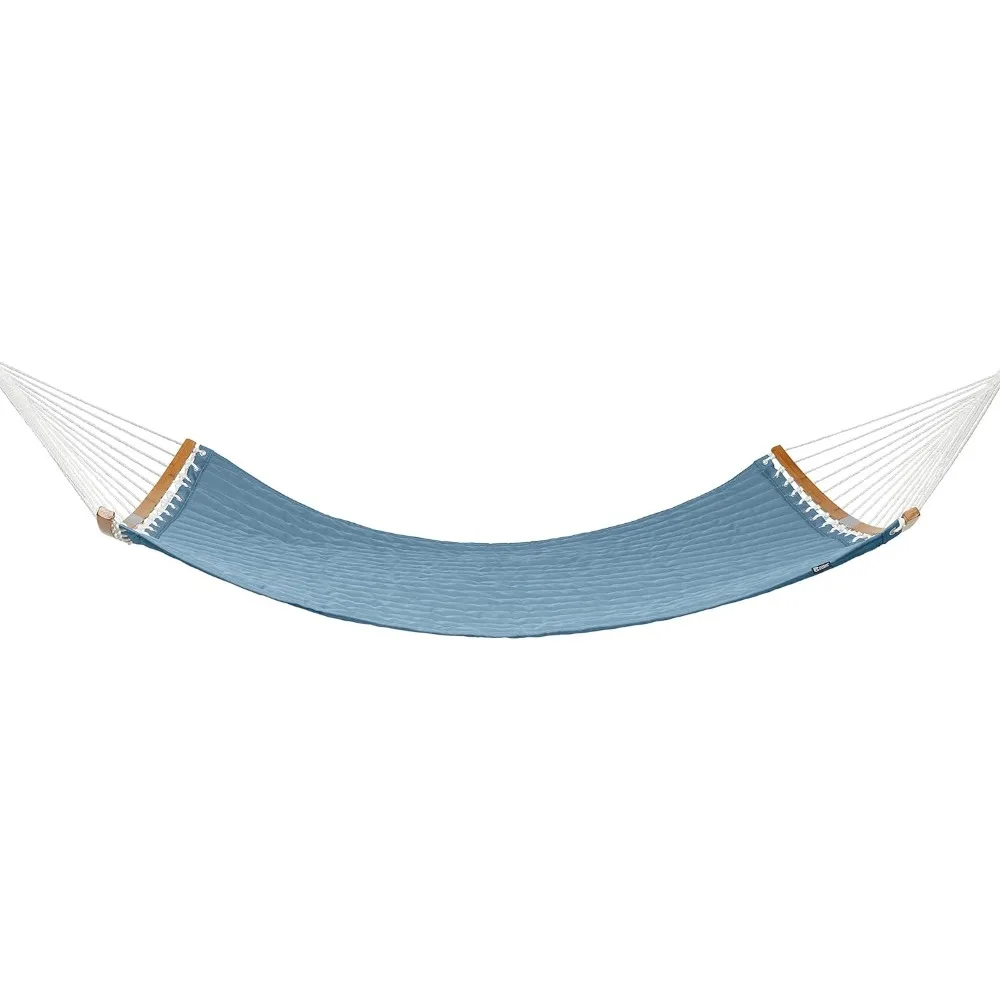
Does Material Quality Really Matter? The Investment Perspective
When considering premium hammock systems, many potential buyers question whether material quality justifies the higher price point. Examining this question from several perspectives provides clarity.
Safety Considerations
Material quality directly impacts weight capacity and structural integrity. Premium materials typically support 450-550 pounds compared to 200-300 pounds for standard options. This additional capacity provides both physical safety and peace of mind, particularly for families or couples using the hammock simultaneously.
Long-Term Value Analysis
While initial costs may be higher, premium materials typically offer significantly longer useful lives:
* Standard hammock stands: 3-5 years of outdoor use
* Premium hammock stands: 10-20+ years of outdoor use
* Standard spreader bars: 2-4 years before replacement
* Premium spreader bars: 7-10+ years before replacement
This extended lifespan reduces the cost per use substantially over time. A premium system costing twice as much but lasting four times longer represents a significant value improvement.
Maintenance Requirements
Higher-quality materials generally require less frequent maintenance, reducing both time investment and ongoing costs for protective products. This difference becomes particularly pronounced in challenging environments like coastal areas or regions with extreme seasonal changes.
How to Identify Quality Materials When Shopping for Spreader Bar Hammocks
Recognizing quality materials requires attention to specific indicators that manufacturers often highlight in better products. These quality markers help consumers make informed decisions.
Wood Quality Indicators:
* Tight, consistent grain patterns without obvious flaws
* Clear specification of wood type (generic terms like “hardwood” often indicate lower quality)
* Multiple layers of protective finish with UV inhibitors
* Smooth transitions at joints with flush surfaces
* End-grain sealing to prevent moisture absorption
Metal Quality Indicators:
* Wall thickness of tubing (heavier indicates greater strength)
* Weld quality – look for smooth, consistent welds rather than rough, spotty connections
* Hardware grade – stainless steel or hot-dipped galvanized indicates quality
* Powder coat thickness and uniformity – should feel substantial, not thin
* Weight often correlates with quality in metal stands (within same design type)
When reviewing online product descriptions, look for specific material details rather than generic terms. Quality manufacturers proudly specify exact materials and treatments because these represent significant value points. Additionally, longer warranties typically indicate manufacturer confidence in material quality and durability.
For in-person shopping, don’t hesitate to test connections by gently twisting joined parts – quality materials and construction should feel solid with minimal movement.
Material Quality Comparison: What Sets Premium Hammock Systems Apart
The market offers hammock systems across various price points, with material differences often explaining the price variation. Understanding these differences helps consumers make appropriate value decisions.
Budget Systems ($100-200)
* Often use unspecified “hardwood” spreader bars with minimal finishing
* Stands typically feature thin-wall steel with basic powder coating
* Connection hardware tends to be lightweight with minimal corrosion protection
* Estimated outdoor lifespan: 2-3 seasons with care
Mid-Range Systems ($200-400)
* Named wood species for spreader bars with basic weather protection
* Heavier gauge steel with proper welding and standard powder coating
* Better hardware with some weather resistance features
* Estimated outdoor lifespan: 3-5 seasons with proper care
Premium Systems ($400+)
* Specifically chosen premium wood species with multiple protective layers
* Heavy-gauge metals with reinforced connection points
* Marine-grade hardware throughout the system
* Comprehensive hammock installation requirements and safety features
* Estimated outdoor lifespan: 7-15+ seasons with basic maintenance
Beyond visible differences, premium systems undergo more rigorous testing procedures, including static load testing at 3-4 times the rated capacity, cyclic testing to simulate years of use, and weathering tests to verify finish durability. These hidden quality elements contribute significantly to the user experience and long-term satisfaction.
At Outside Luxe, we focus on these premium material distinctions because they directly impact the relaxation experience our customers seek – one of confident comfort that lasts season after season.

